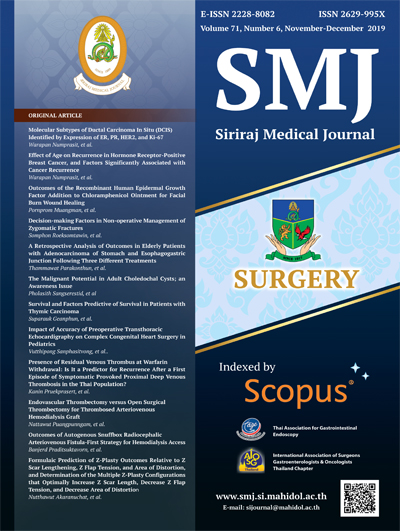Outcomes of the Recombinant Human Epidermal Growth Factor Addition to Chloramphenicol Ointment for Facial Burn Wound Healing
DOI:
https://doi.org/10.33192/Smj.2019.65Keywords:
Burn; wound healing; epidermal growth factorAbstract
Objective: Delayed healing of facial burns can result in scarring and psychological morbidity. Epidermal growth factor may promote wound granulation and angiogenesis to enhance wound healing. We compared the effect of Chloramphenicol ointment alone with Recombinant Human Epidermal Growth Factor (rhEGF) plus chloramphenicol on facial burn wound healing.
Methods: A randomized controlled trial was conducted in patients admitted to the Burn Unit. Subjects aged 18 to 65 years with acute second-degree facial burn wounds that did not require surgical treatment were enrolled. Subjects were divided equally and randomized to receive either topical chloramphenicol ointment twice daily (control) or rhEGF ointment once daily and chloramphenicol ointment twice daily. Wounds were assessed at frequent intervals. Wound size, complete healing day, pain score, infection, side effects, Vancouver Scar Scale and the cost of treatment were recorded.
Results: Twenty-six wounds were enrolled. The mean wound size was similar in both groups (rhEGF plus chloramphenicol treated group 38.5±18.2 cm2 vs control group 42.1±19.4 cm2). Burn wounds in the rhEGF group healed more rapidly, though the difference was not statistically significant (8.5 ± 3.4 days vs 9.3 ± 4.4 days, p=0.3). No difference was observed in the Vancouver scar scale. Mean post-treatment pain scores were the same in both groups. There were no infections or side effects in either group. The rhEGF-treated group was more expensive (1463.1 ± 142.6 vs 19.2 ± 1.9 baht).
Conclusion: There are no difference in outcomes of acute facial burn wound healing treated with rhEGF and chloramphenical ointment compared to chloramphenicol treatment alone. The further study to evaluate the effect of rhEGF in patients who have some factors that delay wound healing should be done.
Downloads
Published
How to Cite
Issue
Section
License
Authors who publish with this journal agree to the following conditions:
Copyright Transfer
In submitting a manuscript, the authors acknowledge that the work will become the copyrighted property of Siriraj Medical Journal upon publication.
License
Articles are licensed under a Creative Commons Attribution-NonCommercial-NoDerivatives 4.0 International License (CC BY-NC-ND 4.0). This license allows for the sharing of the work for non-commercial purposes with proper attribution to the authors and the journal. However, it does not permit modifications or the creation of derivative works.
Sharing and Access
Authors are encouraged to share their article on their personal or institutional websites and through other non-commercial platforms. Doing so can increase readership and citations.















